Short film production — Storyboards / camera angles for movie making.
Case Study: When Kane was Able
When Kane Was Abel was a short film production by NAFA Productions for Tropfest, in which Halyucinations Studios was enagged. This comedy-martial arts short film drew upon the old David Carradine Kung Fu TV series.
Halyucinations Studios handled most much of the pre-production and post-production film editing. Pre-production including story boarding, location scouting, shooting schedules, filming, clip logging, and the post production editing and export to DVD. Producer Tony Chu auditioned actors and crew and Director Malcolm Ian Connell handled Scripting/writing and directorial duties on the day of the shoot.
What follows are samples of the material generated to create the film, which will give you a perspective of the process of short filmmaking.
Short film production — Storyboards / camera angles for movie making.
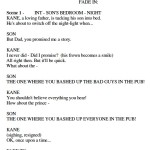
Pre-production
Scripting
The beginning of any movie maker’s adventure starts with the story. Whether it’s a 90-minute feature or a 30-second advertisement film making begins with a story. Our example here was a seven-minute comedy script. The film industry standard is roughly one page of a properly scripted storyline equates to one minute of film. The script delivered to us to work with was on its third draft by Malcolm Ian Connell. Malcolm had requested to direct it to see his storyline to completion, which is not at all an unusual desire but sometimes another’s interpretation of the delivery of a script can open it up to possibilities the writer never envisaged. This is always something worth considering as a writer.
Auditions and rehearsals
Auditions were held at The Illinois Hotel in Five Dock on October 7th and involved a cold read, plus martial artists were asked to demonstrate their moves. The first (and only) rehearsal was booked on Tuesday 12th October, also at the Illinois Hotel, from 6pm till 8pm. From there we went straight to the shoot.
Storyboarding
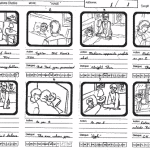
The story needs to be translated into visual media and the first step is the Storyboard – basically a comic book for a film. Here is the storyboard for the opening scene described in the script extract above. The Graphic Artist Halyucinations commissioned for the storyboard was Margie “B”. Margie is a Graphics Artist par excellence (as well as the artist who designed Halyucinations Studios’ logo). Margie’s background in Graphics design began in college when she studied fine arts and graphic design and continued as she worked for various publications as a designer. She also worked as a freelance illustrator, in which capacity she began working for Halyucinations Studios as a layout artist doing the story boards for productions.
Location scouting

The location venue the producer found for the shoot and gained permission to utilise the back bar for, was the Illinois Hotel on 15 Parramatta Road, (cnr Arlington Road) in Five Dock. The bedroom scenes were actually shot last in the actual bedroom of the son of one of the persons involved. The storyboard allowed the Director of Photography (DOP) to measure up the bar and map it out to determine placement of all of the camera angles (there were 22 in the hotel bar) for all 61 scenes and then determine the sequencing of the scenes and develop a sequence for a three-night shoot. The camera angles were all mapped out in a to-scale map of the back bar of the Illinois Hotel and then these were broken down into a daily (or in this case, nightly) schedule.
Scene breakdown

To come up with the camera operator’s angles we’d use in the hotel bar, the storyboard was broken down into a series of scenes and the camera angles necessary to shoot that scene determined. We broke the room up into a series of four quadrants (A,B,C and D) in order to describe to the producer, director and second camera operator the relative positioning and direction of the camera shot. The opening bar scene shot on location (illustrated here), in which Kane enters the bar, required six separate camera angles shot.
We then divided the storyboard into six “scenes” and determined the camera angles for each of them. The result was 61 shots done with 22 Camera angles (as shown in the image above). Keep in mind this was for a seven minute Tropfest film. This preparation was all carried out before a single frame was shot. Knowing the camera angles for each scene in the storyboard/script will not by itself generate the final plan to commence a sequence of shooting objectives. In fact, filming in accordance with such a sequence is predictably the most inefficient and costly way to make a film.
Shot sequencing
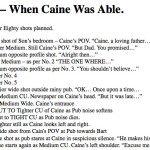
This is the practice of listing all shots in script sequence. The most expensive piece of machinery to use on a film set is the camera. (And by that I don’t mean it’s cost because I am sure many people will say they have lights or props or perhaps actors on whom more money is deployed.) I use the term expensive in terms of what has to accompany the camera. They are lights, sound equipment, actors, props, etc and in particular they way these have to “follow” a camera from position to position. Every time you move the camera so does everything else — hence it’s “expense” in time and logistics on a shooting set. Shooting a film in sequence of the script or storyboard is likely to be the most inefficient and expensive manner of doing so.
Far better indeed to sequence your shooting in terms of camera angles and so reduce the production cost of making a film. If you know all your scenes as depicted by the storyboard and can determine as a result of knowing your location all the possibilities for camera angles, then you can schedule the sequence in which you shoot to be the most cost effective, with the goal being to minimise the travel of the accompanying lights, sound equipment, actors, props, etc.
Film Production
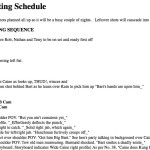
Continuity
In this case, after we mapped out the camera angles, we then rescheduled them for what we hoped would be each day of the shoot. One of the issues that one has to take care of with baseing your shooting around cameras and non-lineal processing is, of course, continuity. The final film will be re-edited in lineal sequence so the shirt the actor wore when he was in a scene on day one has to be worn on day five when the next scene from the storyboard is shot. In fact, it is often not thing like shirts but the placement of props that are mishandled in continuity. So, to this end the continuity crew will draw up their own shot list based on what the Director or Director of Photography (as was this case) has generated to monitor continuity.
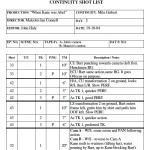
Hence, we started on night one on the first day of shooting with a close up of Bart, our villain, thrusting his fist into “Kane’s face” in a bar fight scene. It was the only scene that required that particular camera angle. From there we turned the camera 180 degrees (as well as the lights, etc) and shot two sequences that were to be edited into the film 10 linear sequences later. In this manner we continued to shoot another 57 sequences for the next three evenings. But as aforementioned, all this paperwork, planning and preparation was made and distributed to cast and crew as they had need before anything was “in the can”.
Actor and film crew scheduling
This also allows for the scheduling of cast and, in this case, because of the unavailability of certain actors at specific times, the shooting schedule was also adjusted to allow actors who could not stay on set till late, to go home early. This was after all a short film with minimal budget. So, the choice to shoot specific angles and to do them early as opposed to late in the evening was also guided by cast and crew availability. So, the choice to shoot the first shot of the “villain” punching the “hero” was because (as you may note on the schedule image above) three actors guaranteed they would be the first on the set.
Logging sheets
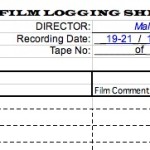
With writing, drawing, mapping, locating, negotiating, scheduling, and paperwork all complete, the first day of the shoot commences. The paper work does not finish here. It would be nice to assume that every shot taken will be perfectly acted; no passing car, train, plane will interfere with sound; no continuity person will forget the cup that should be to the right of the actor; no actor or crew to the side will cough unexpectedly; that the sound boom will not unnoticed wander into the scene from the top of the scene but…
This is why the camera person should consider the perspective of the film editor. A log sheet that that records all the takes and which ones were good, bad or indifferent allows the film editor to commit minimal effort in locating footage to use. This along with the footage generates the guidance for the film editor the knowledge of what footage to load up for reassembling the non-linear sequences into the final film sequence. While in this case one of the cameramen was the film editor, this may not usually be the case. This is the communication from the director and crew as to what shots to use.
Movie making made!
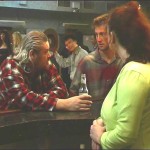
Finally, after four nights of shooting, shuffling cameras, lights, props, actors, crew, the final shot is logged and the cameras closed down, the lights switched off to allow to cool and the actors and crew go home.
Post production
Filmmaking is a collaborative process involving significant numbers of people. This is when the film is handed over to the film editor. This stage of movie making – the post editing – is what director Malcolm Ian Connell once described to me as “the loneliest job in film business”. This collection of entangled hodgepodge of footage has to be reassembled into a coherent linearly sequenced story that may loosely resemble the storyboard.
And so, I sat in a small office, with the occasional company of the Director, for hours in front of a Macintosh computer running Final Cut Pro, regenerating the story. It was cut together, exported onto a DVD and delivered in time to the Tropfest festival coordinators to be judged alongside of some 700 other films.
Film makers closure
Whatever the final result of your film it is important to keep in mind that the journey from conception to screen is rarely what you expect. It is a truism in the film business that there are always three stories generated in the creation of a film: The one you write, the one you film, and the one you edit. It is very unlikely these will ever be the same and in fact more likely not to be. Innumerable writers, film makers and editors have said to me over the years that there is little point being too emotionally attached to your part of the process in the hope that it will ever be what was originally envisaged.
That said, there is a process that one follows in generating a film that serves the process of entertaining, educating, eliciting, informing, whether in the form of a 30-second advertisement, a music video clip, a short or long film. The longer and more complex the film, the more you will need to follow these processes (amongst others) to be able to affordably generate your result. The simpler the film, the easier it is to get away without the paper trail, and manage it all in your film maker’s head, but whatever the case these are all part and parcel of the processes you need to follow to generate your production on film.
And when you want to do this, please remember to contact us!
